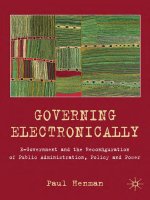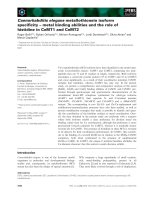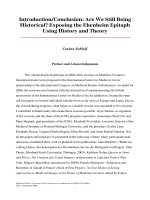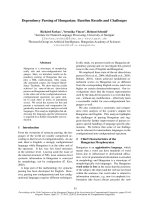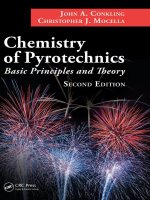Chemistry of Pyrotechnics Basic Principles and Theory potx
Bạn đang xem bản rút gọn của tài liệu. Xem và tải ngay bản đầy đủ của tài liệu tại đây (3.57 MB, 233 trang )
DK4506 Cover 11/17/10 10:43 AM Page 1
C M Y CM MY CY CMY K
Basic Principles and Theory
SECOND EDITION
Chemistry
of Pyrotechnics
6000 Broken Sound Parkway, NW
Suite 300, Boca Raton, FL 33487
270 Madison Avenue
New York, NY 10016
2 Park Square, Milton Park
Abingdon, Oxon OX14 4RN, UK
an informa business
CONKLING
MOCELLA
Chemistry of Pyrotechnics
JOHN A. CONKLING
CHRISTOPHER J. MOCELLA
Primarily driven by advancing technology and concerns for safety, advancement
in the world of pyrotechnics and high-energy materials has exploded in the past
25 years. The promulgation of new government regulations places new and
more stringent restrictions on the materials that may be used in energetic
mixtures. These regulations now mandate numerous training programs and
initiate other actions, such as OSHA’s Process Safety Management standard,
intended to eliminate accidents and incidents. Unfortunately, the United States
lacks an organized, broad-range academic program to cover the science and use
of energetic materials and educate the next generation of pyrotechnicians.
Designed as a bridge to provide a smooth and confident transition for personnel
coming from a chemistry background into the practical world of high-energy
materials, Chemistry of Pyrotechnics: Basic Principles and Theory, Second
Edition emphasizes basic chemical principles alongside practical, hands-on
knowledge in the preparation of energetic mixtures and examines the interactions
between and adaptations of pyrotechnics to changing technology in areas such
as obscuration science and low-signature flame emission.
Much more than a simple how-to guide, the book discusses chemical and
pyrotechnic principles, components of high-energy mixtures, and elements of
ignition, propagation, and sensitivity. It offers heat compositions, including
ignition mixes, delays, thermites, and propellants and investigates the production
of smoke and sound as well as light and color.
Promoting the growth and expansion of pyrotechnics as a science, Chemistry
of Pyrotechnics: Basic Principles and Theory, Second Edition teaches
practitioners how to apply chemical principles and
logic to energetic materials and, thereby, make the
field as productive, useful, and safe as possible.
DK4506
SECOND
EDITION
CHEMISTRY
Chemistry
of Pyrotechnics
Basic Principles and Theory
SECOND EDITION
Cover photo by Rob Stowers, courtesy of Pyrotecnico. Red, white, and blue bursts
highlight a 4th of July reworks spectacular.
Chemistry
of Pyrotechnics
Basic Principles and Theory
SECOND EDITION
CRC Press is an imprint of the
Taylor & Francis Group, an informa business
Boca Raton London New York
JOHN A. CONKLING & CHRIS MOCELLA
CRC Press
Taylor & Francis Group
6000 Broken Sound Parkway NW, Suite 300
Boca Raton, FL 33487-2742
© 2010 by Taylor and Francis Group, LLC
CRC Press is an imprint of Taylor & Francis Group, an Informa business
No claim to original U.S. Government works
Printed in the United States of America on acid-free paper
10 9 8 7 6 5 4 3 2 1
International Standard Book Number-13: 978-1-4200-1809-7 (Ebook-PDF)
This book contains information obtained from authentic and highly regarded sources. Reasonable efforts have been
made to publish reliable data and information, but the author and publisher cannot assume responsibility for the
validity of all materials or the consequences of their use. The authors and publishers have attempted to trace the
copyright holders of all material reproduced in this publication and apologize to copyright holders if permission to
publish in this form has not been obtained. If any copyright material has not been acknowledged please write and let
us know so we may rectify in any future reprint.
Except as permitted under U.S. Copyright Law, no part of this book may be reprinted, reproduced, transmitted,
or utilized in any form by any electronic, mechanical, or other means, now known or hereafter invented, includ-
ing photocopying, microfilming, and recording, or in any information storage or retrieval system, without written
permission from the publishers.
For permission to photocopy or use material electronically from this work, please access www.copyright.com
( or contact the Copyright Clearance Center, Inc. (CCC), 222 Rosewood Drive, Danvers,
MA 01923, 978-750-8400. CCC is a not-for-profit organization that provides licenses and registration for a variety
of users. For organizations that have been granted a photocopy license by the CCC, a separate system of payment
has been arranged.
Trademark Notice: Product or corporate names may be trademarks or registered trademarks, and are used only for
identification and explanation without intent to infringe.
Visit the Taylor & Francis Web site at
and the CRC Press Web site at
v
© 2011 by Taylor & Francis Group, LLC
Contents
Preface to the Second Edition—2010 ix
Preface to the First Edition—1985 xi
Chapter 1 Introduction 1
A Brief History 4
References 6
Chapter 2 Basic Chemical Principles 7
Atoms and Molecules 7
The Mole Concept 15
Electron-Transfer Reactions 17
Oxidation-Reduction Theory 17
The Pyro Valence Method—A Simple Yet Powerful Technique 19
Balancing an Equation 22
Is a Chemical Compound Fuel or Oxygen Rich? 22
What about Methylammonium Perchlorate, CH
3
NH
3
ClO
4
? 23
Weight Ratio Calculations 24
Analyzing a Mixture 25
Three-Component Systems 25
Pyro Valence Exercises 26
Additional Pyro Valence Problems 29
Electrochemistry 30
Thermodynamics 33
Heat of Reaction 34
Rates of Chemical Reactions 38
Energy-Rich Bonds 40
States of Matter 41
Gases 42
Liquids 43
The Solid State 44
Acids and Bases 46
Instrumental Analysis 48
Light Emission 50
Molecular Emission 54
Black Body Emission 54
The Pyrotechnic Laboratory 55
Particle Size
55
Thermal Analysis 56
vi Contents
© 2011 by Taylor & Francis Group, LLC
Moisture Analyzer 56
Heat Output Measurement 56
Other Equipment 56
References 57
Chapter 3 Components of High-Energy Mixtures 59
Introduction 60
Oxidizing Agents 62
Requirements 62
Potassium Nitrate (KNO
3
) 65
Potassium Chlorate (KClO
3
) 65
Potassium Perchlorate (KClO
4
) 69
The Perchlorate Issue—2010 69
Ammonium Perchlorate (NH
4
ClO
4
) 71
Ammonium Perchlorate in the News 72
Strontium Nitrate [Sr(NO
3
)
2
] 72
Barium Nitrate [Ba(NO
3
)
2
] 73
Other Oxidizers 73
Oxidizer Selection: A Comparison 75
Fuels 75
Requirements 75
Metals 77
Aluminum (Al) 78
Magnesium (Mg) 79
Magnalium (Magnesium-Aluminum Alloy) 80
Iron 80
Other Metals 80
Nonmetallic Element Fuels 81
Sulfur 82
Boron 82
Silicon 83
Phosphorus 83
Sulde Compounds 84
Organic Fuels 84
Specic Organic Fuels 86
Carbohydrates 87
Other Organic Fuels 88
Binders 89
Most Binders Are Also Fuels 92
Retardants 93
Catalysts 93
Gas Volume
94
Conclusion 94
References 95
Contents vii
© 2011 by Taylor & Francis Group, LLC
Chapter 4 Pyrotechnic Principles 97
Introduction 97
Variability 102
Requirements for a Good High-Energy Mixture 108
Preparation of High-Energy Mixtures 109
Process Hazard Analysis 111
Variation from Day to Day 111
Possible Areas Where Variation in the Performance
and Sensitivity of Pyrotechnic Mixtures Can Occur
During the Manufacturing Process 112
References 112
Chapter 5 Ignition and Propagation 115
Ignition Principles 116
Summary of Ignition 127
Propagation of Burning 128
Factors 128
Effect of External Pressure 131
Effect of External Temperature 134
Burning Surface Area 135
Summary of Burn Rate 136
Combustion Temperature 136
Propagation Index 140
References 141
Chapter 6 Sensitivity 143
Sensitivity Testing 143
Spark Sensitivity 146
Friction Sensitivity 148
Impact Sensitivity 150
Thermal Sensitivity 152
Redesigning a Composition 156
Summary 157
References 158
Chapter 7 Heat Compositions: Ignition Mixes, Delays, Thermites, and
Propellants 159
Heat Production 160
Delay Compositions 163
Ignition Compositions and First Fires 168
Thermite Mixtures
171
Propellants 172
References 178
viii Contents
© 2011 by Taylor & Francis Group, LLC
Chapter 8 Color and Light Production 179
Introduction 179
White Light Compositions 180
Introduction 180
Photoash Mixtures 183
Sparks 184
Flitter and Glitter 186
Crackle Effects 187
Color 188
Introduction 188
Oxidizer Selection 190
Fuels and Burning Rates 191
Color Intensiers 192
Red Flame Compositions 193
Green Flame Compositions 194
Blue Flame Compositions 196
Purple Flame Compositions 197
Yellow Flame Compositions 198
Beyond the Visible Region 200
References 201
Chapter 9 Smoke and Sound 203
Smoke Production 203
Colored Smoke Mixtures 205
White Smoke Production 208
HC Replacement Research 210
Noise Production 211
Whistles 214
References 215
Appendix A 217
Appendix B 219
ix
© 2011 by Taylor & Francis Group, LLC
Preface to the Second
Edition—2010
In the twenty-ve years that have passed since the rst edition of this book was
published, the world of pyrotechnics and high-energy materials has continued to
undergo signicant changes. The changes have been driven primarily by concerns
for safety—of personnel working with energetic materials and of the communi-
ties located near facilities producing energetic materials—as well as concerns for
the environment. One result of the pressure for change has been the promulgation
of new government regulations placing restrictions on the materials that may be
used in energetic mixtures, mandating numerous training programs, and initiat-
ing other actions, such as OSHA’s Process Safety Management standard, intended
to eliminate accidents and incidents. And almost all of the personnel who entered
the eld of energetic materials in the 1950s and 1960s have now retired and taken
with them their years of hands-on, practical knowledge in the preparation of ener-
getic mixtures.
The International Pyrotechnics Seminars have grown in frequency and signi-
cance since the rst edition of this book was published in 1985. There is now at
least one seminar a year, either in Colorado or a non–United States location, and
the proceedings from these seminars continue to be a great source of information
regarding ongoing pyrotechnic research. In addition, the International Symposium
on Fireworks (ISF) continues to be held every other year in Canada or elsewhere, and
these sessions always produce an interesting blend of technical papers.
The Pyrotechnics Guild International (PGI) has matured into a respected group
of pyrotechnics enthusiasts and researchers who are making signicant contribu-
tions in the area of reworks technology.
A new journal, appropriately named the Journal of Pyrotechnics, has provided a
vehicle for the prompt publication of research and review papers in the broad eld
of pyrotechnics.
On the negative side, we in the United States continue to lack any organized,
broad-range academic programs covering the science of energetic materials. The
New Mexico Institute of Technology is offering a program in explosive technology,
and this is a great rst step. More and more, the eld of pyrotechnics is interacting
with and adapting to changing technology in areas such as obscuration science and
low-signature ame emission. Greater academic interest in the science of pyrotech-
nics would be a valuable asset for this country.
I thank my numerous colleagues and coworkers over the past twenty-ve years for
their interesting discussions, helpful comments, and constructive criticism. First on
the list is Joseph Domanico, my friend and colleague with the Summer Pyrotechnic
Seminar program at Washington College since 1984—Joe is truly a unique indi-
vidual with a broad knowledge of the eld of energetic materials.
x Preface to the Second Edition—2010
© 2011 by Taylor & Francis Group, LLC
I also thank Chris Mocella, Washington College 2001, for his assistance with,
and contributions to, the second edition of this book. Chris also participates as an
instructor in the Summer Pyrotechnic Seminars at Washington College, and has
become a valuable member of the team.
The thank-you list includes Tom Shook and Loy Aikman at Pine Bluff
Arsenal, who got me involved in the military side of pyrotechnics two decades
ago. Another special acknowledgment goes to David Pier of MP Associates, with
whom I have enjoyed debating a wide variety of topics covering many aspects
of energetic material for many years. Other friends and colleagues who have
contributed to my education include the late Fred McIntyre and another for-
mer Washington College chemistry student, Jeff Johnson, with Orion Safety
Products. I also thank the American Pyrotechnics Association for allowing me
time to pursue my scientic interests for many years, and to TNT Fireworks and
Orion Safety Products for allowing me to assist them with interesting projects
since my retirement from the APA. More thanks go to the participants in my
Summer Pyrotechnic Seminar programs for the past twenty-seven years, and to
my friends at the Bureau of Alcohol, Tobacco, and Firearms, and Judy LeDoux
and Debra Satkowiak in particular, for allowing me to assist them with training
for their personnel.
Finally, I must acknowledge the importance of my wife, Sandra, to this proj-
ect, without whose persistent encouragement this second edition would have been
delayed even more. Aiding her in this motivational effort have been my two children,
Melinda Conkling Hart and John A. Conkling Jr., who in addition have presented us
with four wonderful Texas grandchildren—John Maxey Hart, Edward Austin Hart
Jr., Julia Valliant Conkling, and the newest arrival, John A. Conkling III. Maybe one
of them will go on to a career in this fascinating eld.
This book continues to stress basic chemical principles, rather than serve as a
how-to guide for pyrotechnics. There are detailed published works covering many
areas of energetic materials. This book is intended as a bridge to allow people to tran-
sition with condence from a knowledge of chemistry to an ability to apply chemical
principles and logic to energetic materials. Discussion of the historical past of the
eld of pyrotechnics is, regrettably, kept to a minimum. The history of this eld,
particularly the work in the twentieth century, is another book waiting for someone
to pursue, but there should be no doubt in anyone’s mind that pyrotechnics—like any
other eld of science—can only grow and expand as a science by building on past
accomplishments in the eld. Everyone’s goal must continue to be to make the eld
of energetic materials as productive and useful and as safe as possible.
John A. Conkling
Chestertown, Maryland
xi
© 2011 by Taylor & Francis Group, LLC
Preface to the First
Edition—1985
Everyone has observed chemical reactions involving pyrotechnic mixtures. Beautiful
4th of July reworks, highway distress signals, solid fuel boosters for the Space
Shuttle, and the black powder used by muzzle-loading rie enthusiasts all have a
common technical background.
The chemical principles underlying these high-energy materials have been some-
what neglected in the twentieth century by academic and industrial researchers.
Most of the recent work has been goal-oriented rather than fundamental in nature
(e.g., produce a deeper green ame). Many of the signicant results are found in
military reports, and chemical fundamentals must be gleaned from many pages of
test results.
Much of today’s knowledge is carried in the heads of experienced personnel. Many
of these workers acquired their initial training during World War II, and they are
presently fast approaching (if not already past) retirement age. This is most unfortu-
nate for future researchers. Newcomers have a difcult time acquiring the skills and
the knowledge needed to begin productive experiments. A background in chemistry
is helpful, but much of today’s modern chemistry curriculum will never be used by
someone working in pyrotechnics and explosives. Further, the critical education in
how to safely mix, handle, and store high-energy materials is not covered at all in
today’s schools and must be acquired in “on-the-job” training.
This book is an attempt to provide an introduction to the basic principles of high-
energy chemistry to newcomers and to serve as a review for experienced personnel.
It can by no means substitute for the essential “hands on” experience and train-
ing necessary to safely work in the eld, but I hope that it will be a helpful com-
panion. An attempt has been made to keep chemical theory simple and directly
applicable to pyrotechnics and explosives. The level approaches that of an introduc-
tory college course, and study of this text may prepare persons to attend profes-
sional meetings and seminars dealing with high-energy materials and enable them
to intelligently follow the material being presented. In particular, the International
Pyrotechnic Seminars, hosted biannually in the United States by the Illinois Institute
of Technology Research Institute in conjunction with the International Pyrotechnics
Society, have played a major role in bringing researchers together to discuss current
work. The Proceedings of the nine seminars held to date contain a wealth of infor-
mation that can be read and contemplated by persons with adequate introduction to
the eld of high-energy chemistry.
I would like to express my appreciation to Richard Seltzer of the American
Chemical Society and to Dr. Maurits Dekker of Marcel Dekker, Inc. for their encour-
agement and their willingness to recognize pyrotechnics as a legitimate branch of
modern chemistry. I am grateful to Washington College for a sabbatical leave in 1983
xii Preface to the First Edition—1985
© 2011 by Taylor & Francis Group, LLC
that enabled me to nalize the manuscript. I would also like to express my thanks
to many colleagues in the eld of pyrotechnics who have provided me with data
as well as encouragement, and to my 1983 and 1984 Summer Chemistry Seminar
groups at Washington College for their review of draft versions of this book. I also
appreciate the support and encouragement given to me by my wife and children as I
concentrated on this effort.
Finally, I must acknowledge the many years of friendship and collaboration
that I enjoyed with Joseph H. McLain, former Chemistry Department Chairman
and subsequently President of Washington College. It was his enthusiasm and
encouragement that dragged me away from the norbornyl cation and physical
organic chemistry into the fascinating realm of pyrotechnics and explosives. The
eld of high-energy chemistry lost an important leader when Dr. McLain passed
away in 1981.
1
© 2011 by Taylor & Francis Group, LLC
1
Introduction
Welcome to the world of energetic materials. Few people plan to spend their pro-
fessional careers in this eld of science and technology, but there is an old saying
that “once you smell the smoke,” you are hooked.
This book is an introduction to the basic principles and theory of pyrotechnics.
Much of the material is also applicable to the closely related areas of propellants
and explosives. The term high-energy chemistry will be used to refer to all of these
elds. Explosives rapidly release large amounts of energy, and explosives engineers
take advantage of this energy and the associated shock and pressure to do work.
Propellants are designed to burn quite rapidly under the connement of a rocket
engine or a gun barrel, but many propellants burn rather mildly in the open. They
are formulated to maximize the volume of hot gas produced as the propellant rapidly
burns. Pyrotechnic mixtures, in general, react more slowly, and the heat generated
BLACK POWDER GRANULES: (See color insert following page 112) Black powder gran-
ules are the rst commercial energetic material, and have remained an article of commerce for
over one thousand years. This unique blend of potassium nitrate (saltpeter), charcoal, and sulfur
(brimstone) has served as an explosive, a propellant, and a component in pyrotechnic devices such
as safety fuse and squibs. (Photo by Tim Wade and Dennis King, courtesy of MP Associates.)
2 Chemistry of Pyrotechnics
© 2011 by Taylor & Francis Group, LLC
by the burning chemical mixture is used to produce combinations of light, color,
smoke, heat, and noise for a wide range of applications.
The chemical reactions involved are of the electron-transfer, or oxidation-
reduction, type. The mixtures to be studied are almost always solids at room tem-
perature, and are designed to function in the absence of external oxygen. Table1.1
illustrates the reaction rates to be dealt with, which range along a continuum from
very slow burning to “instantaneous” detonations with rates greater than a kilometer
per second. Please note that detonation refers to a specic, shock-propagated process
for the reaction of an energetic material—the term detonation is not synonymous
with ignition or explosion. A detonation is an explosion, but so are high-rate dea-
grations (especially when the material is conned).
It is important to recognize early on that the same material may vary dramatically
in its reactivity, depending on its method of preparation and the conditions under
which it is used. Black powder is an excellent example of this variability, and it is
quite tting that it serves as the rst example of a high-energy material due to its
historical signicance.
1,2
Black powder is an intimate mixture of potassium nitrate
(~75% by weight), charcoal (~15%), and sulfur (~10%), and its unique properties and
characteristics continue to intrigue researchers even today.
3–5
A reactive black powder
is no simple material to prepare, and is a classic example of the “art” of manufactur-
ing pyrotechnics. If one gently mixes the proper ratio of three components briey, a
powder is produced that is difcult to light and burns quite slowly. The same ingredi-
ents in the same proportions—when thoroughly mixed, moistened, and ground with
a heavy stone wheel to achieve a high degree of homogeneity—become a mixture
that readily ignites and burns rapidly. Particle size, purity of the starting materials,
mixing time, and a variety of other factors, including the type of wood used to pre-
pare the charcoal, are all critical in producing high-performance black powder. Also,
deviations from the 75/15/10 ratio of ingredients will lead to substantial changes in
performance. Much of the early history of modern Europe is related to the availabil-
ity of high-quality black powder for use in ries and cannons. A good black powder
manufacturer was essential to military success, although he usually received far less
recognition and decoration than the generals who used his product in their battles.
The burning behavior of black powder illustrates how a pyrotechnic mixture can
vary in performance depending on the conditions of its use. A small pile of loose
TABLE1.1
Classes of High-Energy Reactions
Class
Approximate
Reaction Velocity Example
Burning Millimeters/second Delay mixtures, colored smoke
compositions
Deagration Meters/second Rocket propellants, conned
black powder
Detonation
>1 kilometer/second
Dynamite, TNT
Introduction 3
© 2011 by Taylor & Francis Group, LLC
black powder can be readily ignited by the ame of a match, producing an orange
ash and a puff of smoke, but almost no noise. The same powder, tightly sealed in a
strong paper tube but still in loose condition, will explode upon ignition by means of
a fuse, rupturing the container with an audible noise. Black powder spread in a thin
trail will quickly burn along the trail, a property used in making early fuses. Finally,
if the powder is compressed in a tube, one end is left open, and that end is then con-
stricted to partially conne the hot gases produced when the powder is ignited, a
rocket-type device is produced. This varied behavior, depending on connement, is
quite typical of pyrotechnic mixtures and illustrates why one must be quite specic
in giving instructions for preparing and using the materials discussed in this book.
Black powder is also a good example to use to illustrate the dramatic effect that
moisture can have on pyrotechnic compositions. Damp powder is difcult to light,
and burns quite slowly—if at all—if ignition is successful. “Keep your powder dry”
is still among the best pieces of advice for anyone making or using pyrotechnic
materials, and hygroscopic chemicals—those that tend to rapidly pick up moisture in
a humid environment—tend to be avoided by pyrotechnic formulators.
Why should someone working in pyrotechnics and related areas bother to study
the basic chemistry involved? Throughout the four-hundred-year modern history of
the United States, many black powder factories have been constructed and put into
operation. Although smokeless powder and other new materials have replaced black
powder as a propellant and delay mixture in many applications, there is still a siz-
able demand for black powder in both the military and civilian pyrotechnic indus-
tries. How many black powder factories are operating in the United States today?
Exactly one. The remainder have been destroyed by explosions or closed because of
the probability of one occurring. In spite of a demand for the product, manufacturers
are reluctant to engage in the production of the material because of the history of
problems with accidental ignition during the manufacturing process. Why is black
powder so sensitive to ignition? What can the chemist do to minimize the hazard?
Can one alter the performance of black powder by varying the ingredients and their
percentages, using theory as the approach rather than trial and error?
Black powder is not unique in its properties, however. High-energy materials like
propellants and pyrotechnics are all designed to release energy in brief periods of
time when an ignition stimulus is applied. New formulations continue to be devel-
oped, and new materials continue to be investigated for possible use in novel com-
positions. A pyrotechnic formulation consisting largely of magnesium powder and
polytetrauoroethylene (PTFE; also known as Teon
®
) is used to produce decoy
ares for the protection of military aircraft from heat-seeking missiles. This mate-
rial has acquired a black-powder-like reputation in recent years. Virtually every
manufacturer of this material has suffered an incident producing a magnesium-
Teon composition, and the need to understand the basic science of the material has
received much attention.
6,7
It is this type of problem and its analysis that I hope can
be addressed a bit more thoroughly and scientically with an understanding of the
fundamental concepts presented in this book. If one accident can be prevented as
a consequence of someone’s better insight into the chemical nature of high-energy
materials, achieved through the study of this book, then the effort that went into its
preparation was worthwhile.
4 Chemistry of Pyrotechnics
© 2011 by Taylor & Francis Group, LLC
A BRIEF HISTORY
The use of chemicals, and chemical mixtures, to produce heat, light, smoke, noise,
and motion has existed for several thousand years, originating most likely in China
or India. India has been cited as a particularly good possibility due to the natural
deposits of saltpeter (potassium nitrate, KNO
3
) found there.
8
Much of the early use of chemical energy involved military applications. “Greek
re,” rst reported in the seventh century A.D., was probably a blend of sulfur,
organic fuels, and saltpeter that generated ames and dense fumes when ignited. It
was used in a variety of incendiary ways in both sea and land battles and added a
new dimension to military science.
8
At some early time, most likely prior to 1000 A.D., an observant scientist recognized
the unique properties of a blend of potassium nitrate, sulfur (brimstone), and charcoal,
and black powder was developed as the rst modern high-energy composition.
The Chinese were involved in pyrotechnics at an early date and had developed
rockets by the tenth century.
8
Fireworks followed, including recrackers, and
Chinese recrackers became a popular item in the United States when trade was
begun between the United States and China in the 1800s. Family correspondence
passed down to me shows that my great-great-grandfather, a merchant ship captain
also named John Alexander Conkling, included “recrackers” on his personal shop-
ping list for a voyage to Canton, China (now Guangdong, China), in the 1830s. I was
not aware of this until after I had become involved in the eld of pyrotechnics, but
I was pleased to learn that the Conkling family was among the rst importers of
Chinese reworks into the United States.
Chinese reworks remain popular in the United States today, along with an assort-
ment of other types of pyrotechnic articles that produce a wide assortment of visible
and audible effects. The Japanese also produce beautiful reworks, but curiously,
they do not appear to have developed the necessary technology until reworks were
brought to Japan around 1600 A.D. by an English visitor.
9
Many of the advances in
reworks technology over the past several centuries have come from these two Asian
nations, and China today is the world’s primary supplier of both consumer and display
reworks.
The use of pyrotechnic and propellant mixtures for military purposes in ries,
rockets, ares, and cannons developed simultaneously with the civilian applications,
such as reworks. Progress in both areas followed advances in modern chemistry,
as new chemical compounds were isolated and synthesized and became available
commercially to the pyrotechnician. Berthollet’s discovery of potassium chlorate in
the 1780s resulted in the ability to produce brilliant ame colors using pyrotechnic
compositions, and color was added to the effects of sparks, noise, and motion previ-
ously available using potassium nitrate–based compositions.
The harnessing of electricity led to the manufacturing of magnesium and alu-
minum metals by electrolysis in the latter part of the nineteenth century, and bright
white sparks and whiter light could then be produced. Strontium, barium, and copper
compounds capable of producing vivid red, green, and blue ames also became com-
mercially available during the nineteenth century, and modern pyrotechnic technol-
ogy really took off.
Introduction 5
© 2011 by Taylor & Francis Group, LLC
Simultaneously, the discovery of nitroglycerine in 1846 by Sobrero in Italy, and
Nobel’s subsequent work with dynamite, led to the development of a new generation
of true high explosives that were far superior to black powder for many blasting and
explosives applications. These materials released their chemical energy through the
detonation process, at rates much faster—and with greater accompanying blast pres-
sure and shock—than the deagration process by which propellants and pyrotech-
nics react upon ignition. The development of modern smokeless powder in the latter
part of the nineteenth century—based on nitrocellulose and nitroglycerine—led to
the demise of black powder as the main propellant for guns of all types and sizes.
Although black powder has been replaced in most of its former uses by newer
and more energetic materials, it is important to recognize the role black powder
has played in modern civilization. Tenney Davis, addressing this issue in his classic
book on the chemistry of explosives, wrote: “The discovery that a mixture of potas-
sium nitrate, charcoal, and sulfur is capable of doing useful work is one of the most
important chemical discoveries or inventions of all times … the discovery of the
controllable force of gunpowder, which made huge engineering achievements possi-
ble, gave access to coal and to minerals within the earth, and brought on directly the
age of iron and steel and with it the era of machines and of rapid transportation and
communication.”
10
Black powder remains a viable energetic material today; it ignites
readily and reliably and is quite stable in storage if kept dry, and it is commercially
available in a range of grain sizes, from ne powder to granules the size of kernels
of corn. Black powder is also fascinating because it is one of the very few materials
produced by the chemical industry that is still made today using essentially the same
materials and manufacturing process as was used ve hundred years ago.
Explosives are widely used today throughout the world for mining, excavation,
demolition, and military purposes. Pyrotechnics are also widely used by the mili-
tary for signaling, obscuration, and training simulators. Military technology is con-
stantly striving to keep pace with advances in other areas of technology, such as
thermal detection and night vision equipment. Civilian applications of pyrotechnics
are many and varied, ranging from the common match to highway warning ares
(fusees) to ever-popular reworks and the spectacular special effects used to enhance
movies, rock concerts, professional wrestling matches, sporting events, and theme
park shows.
The reworks industry remains perhaps the most visible example of pyrotechnics
to the general public, and also remains a major user of traditional black powder. This
industry provides the pyrotechnician with the opportunity to fully display his skill
at producing colors and other brilliant visual effects. The use of reworks in the
United States has not diminished. There has been a steady growth in consumption of
reworks from an estimated 30 million pounds in 1976 to over 230 million pounds in
2007, according to data compiled by the American Pyrotechnics Association.
11
Fireworks form a unique part of the cultural heritage of many countries.
12
In
the United States, reworks have traditionally been associated with Independence
Day—the Fourth of July. In England, large quantities are set off in commemoration
of Guy Fawkes Day (November 5), while the French use reworks around Bastille
Day (July 14). In Germany, the use of reworks by the public is limited to one hour
per year—from midnight to 1 a.m. on January 1, but it is reported to be quite a
6 Chemistry of Pyrotechnics
© 2011 by Taylor & Francis Group, LLC
celebration. Much of the Chinese culture is associated with the use of recrackers
to celebrate New Year’s and other important occasions, and this custom has car-
ried over to the Chinese communities throughout the world. The brilliant colors and
booming noises of reworks appear to have a universal appeal to our basic senses,
eliciting “oohs” and “aahs” from spectators regardless of where the reworks are
displayed worldwide.
To gain an understanding of how these beautiful effects are produced, we will
begin with a review of some basic chemical principles and then proceed to discuss
various pyrotechnic systems.
REFERENCES
1. J. Kelly, Gunpowder, New York: Basic Books, 2004.
2. B. Buchanan, Ed., Gunpowder—The history of an international technology, Bath, UK:
Bath University Press, 1996.
3. M. E. Brown and R. A. Rugunanan, A temperature-prole study of the combustion of
black powder and its constituent binary mixtures, Propellants, Explosives, Pyrotechnics,
14, 69 (1989).
4. G. Hussain and G. J. Rees, Combustion of black powder. Part IV. Effect of carbon and
other parameters, Propellants, Explosives, Pyrotechnics, 17, 1 (1992).
5. I. Von Maltitz, Our present knowledge of the chemistry of black powder, Journal of
Pyrotechnics, 14, 27 (2001).
6. N. Kubota and C. Serizawa, Combustion processes of Mg/TF pyrotechnics, Propellants,
Explosives, Pyrotechnics, 12, 145 (1987).
7. T. Kuwahara, S. A. Matsuo, and N. Shinozaki, Combustion and sensitivity characteris-
tics of Mg/TF pyrolants, Propellants, Explosives, Pyrotechnics, 22, 198 (1997).
8. U.S. Army Material Command, Engineering design handbook: Theory and application,
Military Pyrotechnic Series, Part 1, Washington, DC, 1967 (AMC Pamphlet 706–185).
9. T. Shimizu, Fireworks—The art, science and technique, Tokyo: T. Shimizu, 1981.
10. T. L. Davis, The chemistry of powder and explosives. New York: John Wiley & Sons,
1941.
11. American Pyrotechnics Association, www.americanpyro.com.
12. G. Plimpton, Fireworks: A history and celebration, New York: Doubleday, 1984.
7
© 2011 by Taylor & Francis Group, LLC
2
Basic Chemical Principles
Most chemistry courses do not directly discuss energetic materials—explosives,
propellants, and pyrotechnics. However, these materials all involve “chemistry in
action” and produce their energetic output through chemical reactions. Many of the
principles and logical thought processes that are taught in Chem 101 directly apply
to what will be covered in this book. Pyrotechnics are not magic, and the pyrotech-
nic chemist is no longer viewed as a wizard. When you are working in this eld, and
things seem to be making no sense, it’s time to go back to the basics of science.
ATOMS AND MOLECULES
To understand the chemical nature of pyrotechnics and other energetic mixtures,
one must begin at the atomic level. Two hundred years of elegant experiments and
complex calculations have led to our present picture of the atom as the fundamental
BLACK POWDER COMPONENTS: (See color insert following page 112) Potassium
nitrate (white), charcoal (black), and sulfur (yellow) are blended for hours to produce a homo-
geneous blend that has the reactivity associated with high-quality black powder. Purity of the
starting chemicals, the right ratio of the three components by weight, and the proper mixing
process are all necessary for a successful manufacturing process. (Photo by Tim Wade and
Dennis King, courtesy of MP Associates.)
8 Chemistry of Pyrotechnics
© 2011 by Taylor & Francis Group, LLC
building block of matter. An atom consists of a small, dense nucleus containing
positively charged protons and neutral neutrons, surrounded by a large cloud of
light, negatively charged electrons. Table 2.1 summarizes the properties of these
subatomic particles.
A particular element is dened by its atomic number—the number of protons in
the nucleus (which will equal the number of electrons surrounding the nucleus in a
neutral atom). For example, iron is the element of atomic number 26, meaning that
every iron atom will have twenty-six protons in its nucleus. Chemists use a one- or
two-letter symbol for each element to simplify communication; iron, for example,
is given the symbol Fe, from the old Latin word for iron, ferrum. The sum of the
protons plus neutrons found in the nucleus is called the mass number. For some ele-
ments, only one mass number is found in nature. Fluorine (atomic number 9, mass
number 19) is an example of such an element. Other elements are found in nature in
more than one mass number. Iron is found as mass numbers 56 (91.52%), 54 (5.90%),
57 (2.245%), and 58 (0.33%). These different mass numbers of the same element
are called isotopes, and vary in the number of neutrons found in the nucleus, and
therefore vary in their mass as well. Atomic weight refers to the average mass found
in nature of all the atoms of a particular element; the atomic weight of iron is 55.847.
For calculation purposes, these atomic weights are used for the mass of a particular
element. Table2.2 contains symbols, atomic numbers, and atomic weights for the
elements.
Chemical reactivity, and therefore pyrotechnic and explosive behavior, is deter-
mined primarily by the tendency for each element to gain or lose electrons during
a chemical reaction. Calculations of theoretical chemists, with strong support from
experimental studies, suggest that electrons in atoms are found in orbitals, or regions
in space where they possess the lowest possible energy—close to the nucleus but
away from other negatively charged electrons. As electrons are placed into an atom,
energy levels close to the positive nucleus are occupied rst, and the higher energy
levels are then successively populated. Extra stability appears to be associated with
completely lled levels, termed shells. Elements with completely lled shells include
helium (atomic number 2), neon (atomic number 10), argon (atomic number 18), and
krypton (atomic number 36). These elements all belong to a group called the inert
TABLE2.1
Properties of the Subatomic Particles
Particle Location Charge Mass, amu
a
Mass, grams
Proton In nucleus
+1
1.007 1.673 × 10
–24
Neutron In nucleus 0 1.009 1.675 × 10
–24
Electron Outside nucleus –1 0.00549 9.11 × 10
–28
a
amu = atomic mass unit, where 1 amu = 1.66 × 10
–24
grams.
Basic Chemical Principles 9
© 2011 by Taylor & Francis Group, LLC
TABLE2.2
Symbols, Atomic Weights, and Atomic Numbers of the Elements
Element Symbol Atomic Number Atomic Weight, amu
a
Actinium Ac 89 [227]
b
Aluminum Al 13 26.9815386
Americium Am 95 [243]
Antimony Sb 51 121.760
Argon Ar 18 39.948
Arsenic As 33 74.92160
Astatine At 85 [210]
Barium Ba 56 137.327
Berkelium Bk 97 [247]
Beryllium Be 4 9.012182
Bismuth Bi 83 208.98040
Bohrium Bh 107 [272]
Boron B 5 10.811
Bromine Br 35 79.904
Cadmium Cd 48 112.411
Cesium Cs 55 132.9054519
Calcium Ca 20 40.078
Californium Cf 98 [251]
Carbon C 6 12.0107
Cerium Ce 58 140.116
Chlorine Cl 17 35.453
Chromium Cr 24 51.9961
Cobalt Co 27 58.933195
Copernicium CN 112 [285]
Copper Cu 29 63.546
Curium Cm 96 [247]
Darmstadtium Ds 110 [281]
Dubnium Db 105 [268]
Dysprosium Dy 66 162.500
Einsteinium Es 99 [252]
Erbium Er 68 167.259
Europium Eu
63 151.964
Fermium Fm 100 [257]
Fluorine F 9 18.9984032
Francium Fr 87 [223]
Gadolinium Gd 64 157.25
Gallium Ga 31 69.723
Germanium Ge 32 72.64
Gold Au 79 196.966569
Hafnium Hf 72 178.49
Hassium Hs 108 [270]
Helium He 2 4.002602
Holmium Ho 67 164.93032
(continued)
10 Chemistry of Pyrotechnics
© 2011 by Taylor & Francis Group, LLC
TABLE2.2 (CONTINUED)
Symbols, Atomic Weights, and Atomic Numbers of the Elements
Element Symbol Atomic Number Atomic Weight, amu
a
Hydrogen H 1 1.00794
Indium In 49 114.818
Iodine I 53 126.90447
Iridium Ir 77 192.217
Iron Fe 26 55.845
Krypton Kr 36 83.798
Lanthanum La 57 138.90547
Lawrencium Lr 103 [262]
Lead Pb 82 207.2
Lithium Li 3 6.941
Lutetium Lu 71 174.9668
Magnesium Mg 12 24.3050
Manganese Mn 25 54.938045
Meitnerium Mt 109 [276]
Mendelevium Md 101 [258]
Mercury Hg 80 200.59
Molybdenum Mo 42 95.96
Neodymium Nd 60 144.242
Neon Ne 10 20.1797
Neptunium Np 93 [237]
Nickel Ni 28 58.6934
Niobium Nb 41 92.90638
Nitrogen N 7 14.0067
Nobelium No 102 [259]
Osmium Os 76 190.23
Oxygen O 8 15.9994
Palladium Pd 46 106.42
Phosphorus P 15 30.973762
Platinum Pt 78 195.084
Plutonium Pu 94 [244]
Polonium Po 84 [209]
Potassium K 19
39.0983
Praseodymium Pr 59 140.90765
Promethium Pm 61 [145]
Protactinium Pa 91 231.03588
Radium Ra 88 [226]
Radon Rn 86 [222]
Rhenium Re 75 186.207
Rhodium Rh 45 102.90550
Roentgenium Rg 111 [280]
Rubidium Rb 37 85.4678
Ruthenium Ru 44 101.07
Rutherfordium Rf 104 [267]
Samarium Sm 62 150.36
Basic Chemical Principles 11
© 2011 by Taylor & Francis Group, LLC
gases, and their virtual lack of any chemical reactivity provides support for the the-
ory of lled-shell stability—the atoms do not wish to gain, lose, or share electrons.
Other elements show varying tendencies to obtain a lled shell by the sharing of
electrons with other atoms, or by the actual gain or loss of electrons to form charged
species, called ions. For example, sodium (symbol Na, atomic number 11) readily
loses one electron to form the sodium ion, Na
+
, with ten electrons. By losing one
TABLE2.2 (CONTINUED)
Symbols, Atomic Weights, and Atomic Numbers of the Elements
Element Symbol Atomic Number Atomic Weight, amu
a
Scandium Sc 21 44.955912
Seaborgium Sg 106 [271]
Selenium Se 34 78.96
Silicon Si 14 28.0855
Silver Ag 47 107.8682
Sodium Na 11 22.98976928
Strontium Sr 38 87.62
Sulfur S 16 32.065
Tantalum Ta 73 180.94788
Technetium Tc 43 [98]
Tellurium Te 52 127.60
Terbium Tb 65 158.92535
Thallium Tl 81 204.3833
Thorium Th 90 232.03806
Thulium Tm 69 168.93421
Tin Sn 50 118.710
Titanium Ti 22 47.867
Tungsten W 74 183.84
Ununhexium Uuh 116 [293]
Ununoctium Uuo 118 [294]
Ununpentium Uup 115 [288]
Ununquadium Uuq 114 [289]
Ununtrium Uut 113 [284]
Uranium U 92 238.02891
Vanadium V 23 50.9415
Xenon Xe 54 131.293
Ytterbium Yb 70 173.054
Yttrium Y 39 88.90585
Zinc Zn 30 65.38
Zirconium Zr 40 91.224
Source:
Based on the 2005 table in Weizer, M. E. Pure Appl. Chem., 78, 2051–2066, 2006. http://
IUPAC.org/publications/pac/78/11/2051/
a
mu = atomic mass unit, where 1 amu = 1.66 × 10
–24
grams.
b
Value enclosed in brackets is the mass number for the longest-lived isotope.
c
Elements 112 through 118 are currently under review.
12 Chemistry of Pyrotechnics
© 2011 by Taylor & Francis Group, LLC
electron, sodium has acquired the same number of electrons as the inert gas neon, and
it has become a very stable chemical species. Fluorine (symbol F, atomic number 9)
readily acquires one additional electron to become the uoride ion, F
–
. This is another
ten-electron species and is quite stable. Other elements display similar tendencies to
gain or lose electrons to acquire inert gas electron congurations by becoming posi-
tive or negative ions. Many chemical species found in nature are ionic compounds.
These are usually found as crystalline solids composed of interpenetrating lattices
of positive and negative ions held together by electrostatic attraction between these
oppositely charged particles. Table salt, or sodium chloride, is an ionic compound
consisting of sodium and chloride ions, Na
+
and Cl
–
, and one uses the formula NaCl
to represent the one-to-one ionic ratio. The attractive forces holding the solid together
are called ionic bonds.
Hence, if one brings together a good electron donor (such as a sodium atom) and
a good electron acceptor (such as a uorine atom), one might expect a chemical
reaction to occur. Electrons are transferred and an ionic compound (sodium uoride,
NaF) is produced. A three-dimensional solid lattice of sodium and uoride ions is
created, where each sodium ion is surrounded by uoride ions, and each uoride ion
is in turn surrounded by sodium ions. Another very important aspect of such a rela-
tion is the fact that energy is released as the product is formed. This release of energy
associated with the formation of the reaction products becomes very important in the
consideration of the chemistry of pyrotechnics and explosives.
In addition to forming ions by electron transfer, atoms may share electrons with
other atoms as a means of acquiring lled shells (and their associated stability). The
simplest illustration of this is the combination of two hydrogen atoms (symbol H,
atomic number 1) to form a hydrogen molecule:
H + H → H – H (H
2
, a hydrogen molecule) (2.1)
The sharing of electrons between two atoms is called a covalent bond. Such bonds
owe their stability to the interaction of the shared electrons with both positive nuclei.
The nuclei will be separated by a certain distance—termed the bond distance—
that maximizes the nuclear-electron attractions balanced against the nuclear-nuclear
repulsive forces. A molecule is a neutral species of two or more atoms held together
by covalent bonds.
The element carbon (atomic number 6, symbol C) is almost always found in nature
covalently bonded to other carbon atoms or to a variety of other elements (most com-
monly H, O, and N). Due to the presence of carbon-containing compounds in all
living things, the chemistry of carbon compounds is known as organic chemistry.
Most high explosives are organic compounds. Trinitrotoluene (TNT), for example,
consists of C, H, N, and O atoms, with a molecular formula for C
7
H
5
N
3
O
6
. When
TNT detonates, it produces a mixture of stable, small molecules such as N
2
, CO
2
, and
H
2
O as reaction products. We will encounter other organic compounds in our study
of fuels and binders in energetic mixtures.
